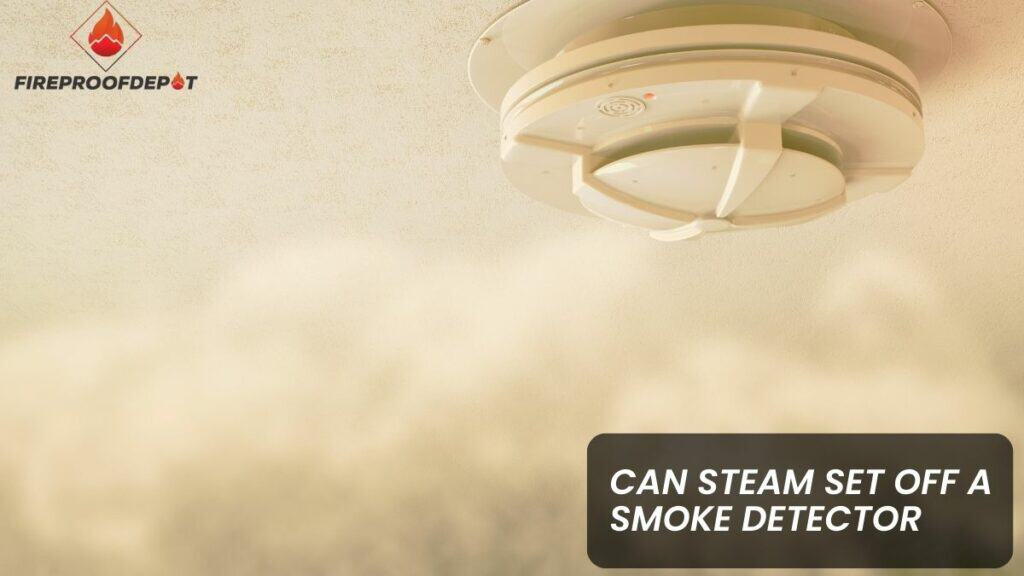Yes, steam can set off a smoke detector, particularly if the steam is dense or carries particles that resemble smoke.
Some smoke detectors are sensitive to changes in humidity or airborne particles, leading to potential false alarms when exposed to steam or certain conditions.
Though it might sound unlikely, many people have already suffered from the problem.
Let me help you understand why it happens and how you can get rid of the problem.

Why Does Steam Make Your Smoke Detector Alarm?
Why does something as innocent as steam set off this vigilant sentinel of fire safety? Let’s explore the intriguing science behind this phenomenon.
Sensitivity to Airborne Particles
Smoke detectors are designed to be highly sensitive to airborne particles produced during combustion, such as those emitted by burning food or a real fire.
The presence of smoke particles allows the detector’s internal sensors to identify the potential danger and promptly alert residents, and that also includes steam.
Density and Temperature
The key lies in the density and temperature of the steam. When water vapor from steam reaches the smoke detector, it can be mistaken for smoke due to its similar appearance.
In certain circumstances, especially in compact kitchens or bathrooms with poor ventilation, the steam can become denser and linger in the air, increasing the likelihood of false alarms.
Condensation and Aerosols
As steam cools down, it may condense into tiny water droplets or aerosols that remain suspended in the air. These microscopic water particles can sometimes carry trace amounts of airborne particles. The smoke detector can interpret these particles as smoke and trigger the alarm.
Humidity and False Alarms
High humidity levels can also contribute to false alarms. If the smoke detector is placed in an area with elevated humidity, the excess moisture in the air can cause a buildup of condensation on the detector’s sensors.
Accumulated Dust
Dust particles settling on the smoke detector over time can further exacerbate false alarms. When steam interacts with the dust, it can create a cloud of tiny particles that resemble smoke, fooling the detector’s sensors and prompting them to activate.
What Usually Sets Off A Smoke Detector?
You must be wondering what actually sets off a smoke detector since it can be tricked by steam. Well, here is what happens:
- Smoke detectors are triggered by the presence of smoke particles in the air.
- Sources such as cooking mishaps, burning materials, or fire incidents can produce the smoke that sets off the detector.
- The internal sensors of the smoke detector can detect microscopic particles from combustion processes.
- Once smoke particles are detected, the smoke detector activates its alarm to alert occupants of potential fire hazards.
How To Prevent Steam From Setting Off A Smoke Detector?
Protecting your home shouldn’t mean enduring annoying false alarms from steam-triggered smoke detectors. Implement these simple measures to prevent steam from setting off your smoke detector.
| Proper Ventilation | Ensure good ventilation in the kitchen and bathroom areas to allow steam to disperse quickly. When cooking or taking a shower, open windows or use exhaust fans. |
| Relocate Smoke Detector | If possible, move the smoke detector away from the kitchen or bathroom, reducing its exposure to steam and humidity. |
| Regular Maintenance | Keep the smoke detector clean and free from dust or debris, which can exacerbate false alarms. Regularly change the batteries to ensure optimal functioning. |
| Use Steam Deflectors | Install steam deflectors or hoods over stove tops to redirect steam away from the smoke detector and prevent it from triggering a false alarm. |
| Cooking Techniques | Opt for cooking techniques that produce less steam, such as using lids on pots and pans or steaming food with minimal water. |
| Humidity Control | Maintain indoor humidity levels with the help of a dehumidifier to reduce the chances of false alarms caused by high humidity. |
| Cleaning Cooking Area Regularly | Regularly clean the cooking area to minimize the presence of grease or cooking residue, which can interact with steam and activate the detector. |
| Consider Different Detector Types | If false alarms persist, consider using a different type of smoke detector, such as a photoelectric one, which might be less sensitive to steam. |
Conclusion
Steam can indeed set off a smoke detector under specific circumstances. While steam itself doesn’t contain smoke particles, its density, temperature, and interaction with humidity and airborne particles can lead to false alarms.
Proper ventilation, strategic detector placement, regular maintenance, and considering alternative detector types can help prevent these unwarranted disruptions.
